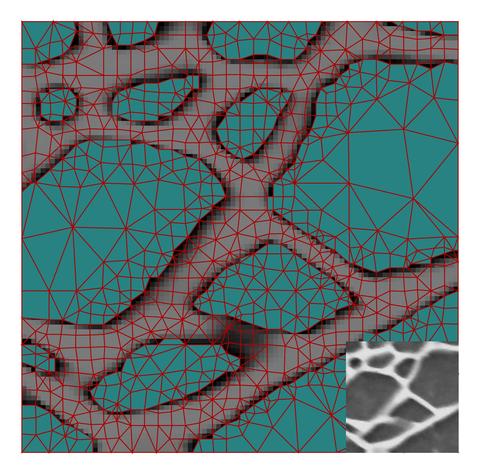
Once provided with a microscope's image of a composite material (inset), OOF software can help analyze the effects of stress on the material's internal structure. Using OOF, researchers can identify the different substances (blue and gray areas) that make up the material and compute their response to stress or other effects, providing clues about how the overall sample will behave.
Before you can build that improved turbojet engine, before you can create that longer-lasting battery, you have to ensure all the newfangled materials in it will behave the way you want—even under conditions as harsh as the upper atmosphere at supersonic speed, or the churning chemistry of an ion cell. Now computer scientists at the National Institute of Standards and Technology (NIST) have improved software* that can take much of the guesswork out of tough materials problems like these.
The software package, OOF (Object-Oriented Finite element analysis) is a specialized tool to help materials designers understand how stress and other factors act on a material with a complex internal structure, as is the case with many alloys and ceramics. As its starting point, OOF uses micrographs—images of a material taken by a microscope. At the simplest level, OOF is designed to answer questions like, "I know what this material looks like and what it's made of, but I wonder what would happen if I pull on it in different ways?" or "I have a picture of this stuff and I know that different parts expand more than others as temperature increases—I wonder where the stresses are greatest?"
OOF has been available in previous versions since 1998, but the new version (2.1) that the NIST team released on Feb. 16, 2011, adds a number of improvements. According to team member Stephen Langer, version 2.1 is the first dramatic extension of the original capabilities of the software.
"Version 2.1 greatly improves OOF's ability to envision 'non-linear' behavior, such as large-scale deformation, which plays a significant role in many types of stress response," says Langer. "It also allows users to analyze a material's performance over time, not just under static conditions as was the case previously."
Jet turbine blades, for example, can spin more efficiently with a layer of ceramic material sprayed onto their surfaces, but the ceramic layers are brittle. Knowing how these ceramic layers will respond as the metal blades heat up and expand over time is one of the many problems OOF 2.1 is designed to help solve.
"We've also included templates programmers can use to plug in their own details and formulas describing a particular substance," Langer says. "We're trying to make it easy for users to test anything—we're not concentrating on any particular type of material."
Later this year, the team expects to enable users to analyze three-dimensional micrographs of a material, rather than the 2-D "slices" that can be analyzed at this point.
* OOF is available for free download at http://www.ctcms.nist.gov/oof/oof2/. The package runs on Unix™ like systems, including Linux, OS X and Linux-like environments within Windows.

